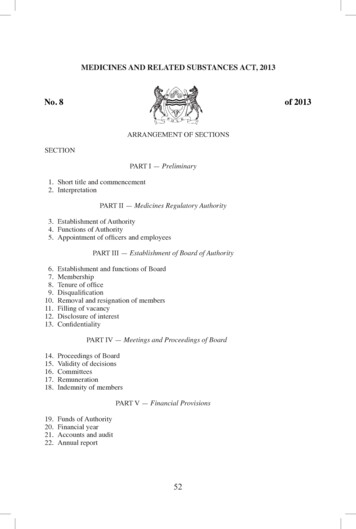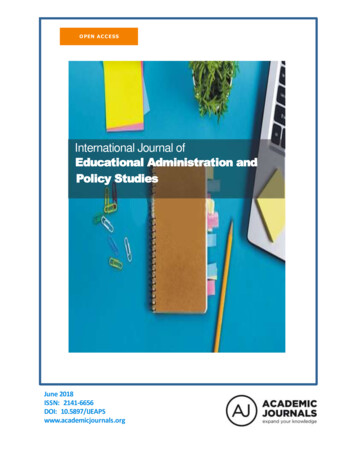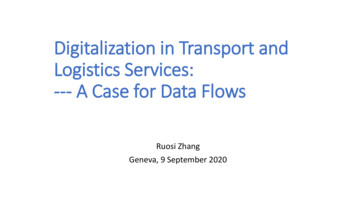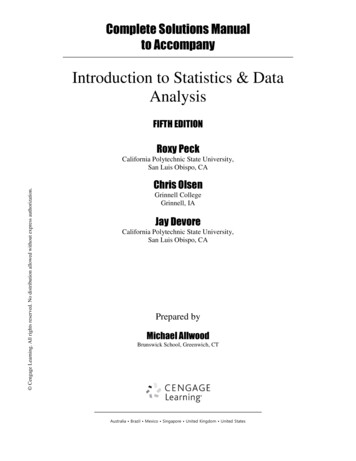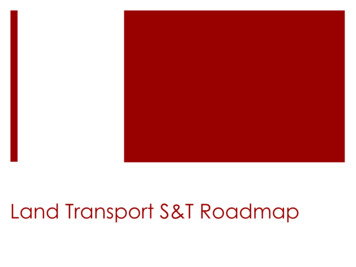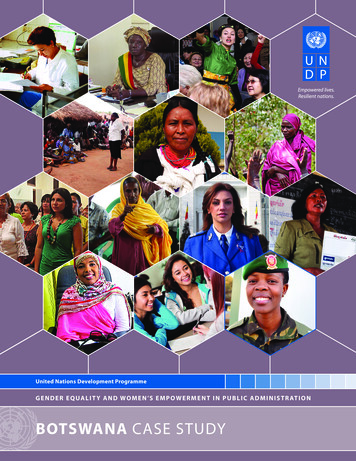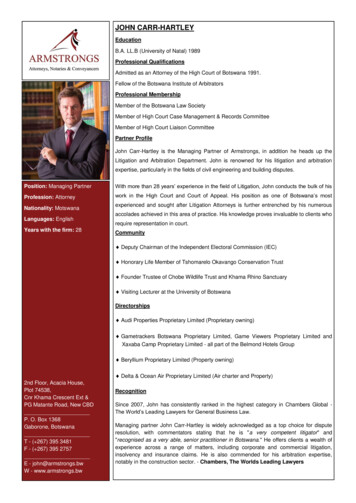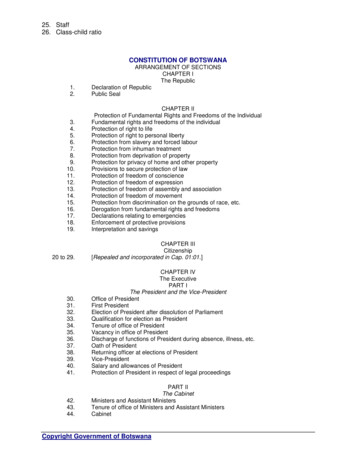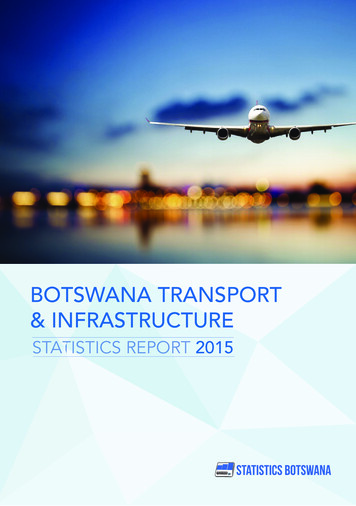
Transcription
BOTSWANA TRANSPORT& INFRASTRUCTURESTATATTISTICS REPOTISORT 2015O
Published bySTATISTICS BOTSWANAPrivate Bag 0024, GaboroneTel: 3671300 Fax: 3952201E-mail: info@statsbots.org.bwWebsite: www.statsbots.org.bwDecember 2016ISBN NO:Copyright Statistics Botswana 2016
BOTSWANA TRANSPORT& INFRASTRUCTURESSTATISSTICS REPOPORT 2015PO
TABLE OF CONTENTSPREFACEABBREVIATIONSEXECUTIVE SUMMARY 11. INTRODUCTION 12. ROAD TRANSPORT 12.1 Road Network 12.2 Motor Vehicle Registrations 52.3 Government Vehicle Stock 103. ROAD SAFETY 103.1 Accident Trend 10/113.2 Accident Severity 11/123.2.1 Accident Severity by Junction Control 123.2.2 Accident Severity by Day of the Week133.2.3 Accident Severity by Time of Occurrence13/14/153.2.4 Accident Severity by Road Surface Type163.3 Casualties 17/284. AIR TRANSPORT 284.1 Aircraft Movements 29/304.2 Air Passenger Movements 30/324.3 Air Cargo & Mail Traffic335. RAILWAY TRANSPORT 345.1 Rail Network 345.2 Revenue From Railway Goods Traffic345.3 Dry Port 356. WATER 357. THE CONTRIBUTION OF THE TRANSPORT SECTOR TO THE ECONOMY368. UTILITIES 378.1 Power 37APPENDICES 40Appendix 1: Motor Vehicle Registrations 40/41Appendix 2: Road Safety 59Appendix 3: Air Transport 66
PrefaceThis report presents a summary of Transport and Infrastructure Statistics for the calendar year 2015. It presents statistics relating to road netwok, motor vehicle population, road accidents, freight movement by rail,aviation, water, Power and Gross Domestic Product attributed to the transport industry.For more information and further enquiries, contact the Directorate of Stakeholder Relations on 3671300.This publication, and all other Statistics Botswana outputs/publications are available on the website at(http://www.statsbots.org.bw) and at the Information Resource Centre (Head-Office, Gaborone).Statistics Botswana acknowledges and extends gratitude to the various Government departments and/ororganisations that provided information for this publication.A. N. MajelantleStatistician GeneralDecember 2016
Abbreviations. Not Available- Zero Value“BA” PermitBotswana Annual Operations PermitKg KilogramLDVLight Duty Vehicle“N” North“P” PermitPassenger Permit“S” South“W” WestMTCMinistry of Transport and CommunicationsGovtGovernmentKmKilometreCTOCentral Transport OrganizationNon-schNon scheduledSchedScheduled
EXECUTIVE SUMMARY1. NTRODUCTIONThis report presents Botswana Transport and Infrastructure statistics for the year 2015under the following themes: Road Transport Road Safety Air Transport Railway Transport Contribution of Transport and Communications to GDP Water Power2. ROAD TRANSPORT2.1 Road NetworkRoads in Botswana are managed and maintained under two authorities, LocalAuthorities and the Central Government.Total road network in 2015 measured 30,275.64 km, of which 18,507 km (61.1 percent)was under the care of Central Government while 11,768.64 km (38.9 percent) wasmaintained by Local authorities. Roads maintained by Central Government remainedconstant at 18,507 km from 2013 to 2015. Out of this 18,507 km, 6,925 km (37.4percent) is bitumen, 7,560 km (40.8 percent) gravel and 4,022 km (21.7 percent) issand. See Table 2.1a, 2.1b and Figure 1.Figure 1: Total Road Network (Percent), 2015InterlockingBricks, 0.1Earth, 15.8Bitumen, 33.4Sand, 15.7Gravel, 35.11
Table 2.1a: Length of Roads Maintained by the Central Governmentby Type (km), 7Percent of ource: Department of Roads, Ministry of Transport and CommunicationsTotal road network maintained by Local Authorities in 2015 remained the same as in2014, at 11,768.64 km. Local Authorities are in charge of access roads which are lessthan 10 km and all the internal roads. The Central District had more tertiary roadsthan other districts, it had 24.7 percent of total tertiary roads. The Kweneng Districtfollowed with 13.6 percent. The Southern and Kgatleng Districts were next with 10.8percent and 8.8 percent respectively. Most of the roads in these districts were mostlyearth. Earth roads in the Central District constituted 49.1 percent of the total roads inthe area while in Kweneng and Southern districts they constituted 58.1 percent and68.9 percent respectively. (See Table 2.1band 2.1c).2
Table 2.1b: Length of Roads Maintained by the Local Authorities by District and Type, 2015District/City/TownSand/ 518.00302.57.332.52FrancistownTar Interlocking 00107.7080.80.702.90LobatseNorth EastNorth West.262.50195.50261.72.719.72Selibe Phikwe.23.7421.52193.16.238.42South ,7693,0663,1761711,768.64TotalSource: Ministry of Local Government3
Table 2.1c: The Proportion of Roads Maintained by the Local Authorities byDistrict and Type, 2015District/City/TownSand/ TrackEarthGravelTarInterlocking BricksTotalPercent of 5.30.01000.00.00.199.70.2100LobatseNorth East10.762.515.311.50.0100North West0.036.527.236.40.0100Selibe Phikwe0.010.09.081.00.0100South 1100Percent of .00.00.05.21.81.4North East10.29.23.52.50.06.0North West0.05.56.48.20.06.1Selibe Phikwe0.00.50.76.10.02.0South 0100Source: Ministry of Local Government4
2.2 Motor Vehicle RegistrationsThe annual stock of vehicles comprises of government owned motor vehicles andprivately owned motor vehicles.2.2.1 National Vehicle StockThe number of licensed vehicles in Botswana increased by 7.8 percent in the yearunder review, from 435,750 vehicles in 2014 to 469,664 vehicles in 2015. Fom 2006 to2015, the national vehicle stock increased by 122.03 percent, growing at an averageannual rate of 10.0 percent. This is shown in Table 1 of Appendix 1 and figure 2below.Figure 2: National Vehicle Stock, 2006-2015500000450000No of 2012201320142015YearsA large number of vehicles are privately owned (97.3 percent), while only 2.6percent are government owned. The increase in vehicle stock has resulted in theconstruction of better roads and an increase in revenue collected from registrationand licensing of vehicles as well as from permits issued to goods and passengercarrying vehicles. On the flip side, this development has brought with it somemajor challenges, for example, an increase in road accidents as shown in section 3.This growth is also likely to negatively impact on the durability or life span of ournational roads, particularly in the more populated areas such as the eastern part ofBotswana.2.2.2 Private Vehicle StockIn 2015, total privately owned vehicles increased from 425,526 in 2014, to 457,407,which is an increase of 7.5 percent. All categories of vehicles, except Tankers andHorses, experienced growth. The most notable growth was in passenger cars whichregistered a 10.7 percent growth after increasing from 250,788 vehicles in 2014 to277,730 vehicles in 2015. As was the case with passenger cars, buses increased aswell and registered a growth of 8.0 percent. See Table 2 in Appendix 1 and Figure3.Vehicles per 1,000 population was 209.1 in 2015, an increase of 5.5 percent from198.2 in 2014. As the private vehicle population continues to grow, it negativelyaffects public transport. This means strategies should be put in place to makepublic transport more attractive, e.g. by creating lanes solely dedicated for publictransport. (see Table 2, Appendix 1).5
Figure 3: Private Vehicle Stock, 2006 - 2015500,000450,000No. of Vehicles400,000333,461350,000300,000250,000 200,134200,000219,403245,738357,104389,815 1 Privately Owned Vehicles - First RegistrationsSince 2006, vehicles registered for the first time have been growing at an averageof 9.1 percent annualy. In 2015, vehicles registered for the first time went up by 11.2percent, from 41,413 vehicles in 2014 to 46,045 vehicles in 2015. The increase wasattributed to import cars from Asia and the United Kingdom which are proving to bemore affordable to the low income market. See Table 3 in Appendix 1 and figure 4below.No. of VehiclesFigure 4: Privately Owned Vehicles - First Registrations by Type ofVehicle, 2006 - 1320142015
2.2.2.2 Privately Owned Vehicles - First Registrations by Type of Vehicle andRegistration StationRegistration Stations under the custody of the Department of Road Transport andSafety (DRTS) are found all over the country, some of which are housed in PostOffices. This is an initiative aimed at reducing distances that people travel to thenearest licensing offices and to enable the Department of Road, Transport andSafety to cope with the ever growing vehicle population. There are currently 27DRTS licensing offices nationwide, including post offices. Stations like Gaboronehave more than one licensing office in order to cope with the volume of vehicles inthe city.The type of vehicle which had a high number of first registrations was the passengercar with 74.6 percent of total first registrations. It was followed by vans with 9.5percent. The vehicle category with the least number of first registrations was thebus with 0.4 percent. Gaborone contributed 38.9 percent of the first registrations,followed by Mogoditshane with 30.3 percent and Francistown with 10.5 percent(Tables 4a and 4b, Appendix 1).2.2.2.3 Privately Owned Vehicles - First Registrations by Type of Vehicle andMonth and QuarterA greater number of vehicles was registered in the last two quarters of 2015,with 56.4 percent of first registrations done in Q3 and Q4. The least number,20.0 percent, of vehicles was registered in Q1, 2015. For the first, second andfourth quarters, most of the registrations were done in the last month of thosequarters. In the first three months (January, February, and March), the bulk ofthe registrations were done in the month of March (36.4 percent) while the leastnumber of registrations was done in January (31.6 percent). During Q2 2015,most of the registrations were done in June (36.7 percent) while in Q4 2015 37.7percent of registrations were done in December. In the third quarter, 34.2 percentof registrations were done in July, which is the highest for that quarter. The leastnumber of registrations were done in August (32.1 percent). See Table 2.2 belowand Table 5a and 5b in Appendix 1.7
Table 2.2: Privately Owned Vehicles - First Registrations by Type of Vehicle & Quarter, 2015PassengerCarsLDVs TrucksBusesMotorCyclesTractors TrailorsTankers/Horses OthersTotalNumber1st Quarter6,5741,0564563626016441940749,2052nd Quarter8,1761,06952838452126437545910,8853rd Quarter9,5411,08160644763183505715012,5474th 3802,1831,6922467641,93721825346,045TotalPercent of Total1st Quarter19.124.120.921.424.421.521.618.329.220.02nd Quarter23.824.424.222.721.116.522.624.823.323.63rd Quarter27.824.727.826.425.624.026.132.619.827.24th al100100100100100100100100100100Percent of Total1st Quarter71.411.55.03.90.71.84.60.40.81002nd Quarter75.19.84.93.50.51.24.00.50.51003rd Quarter76.08.64.83.60.51.54.00.60.41004th 4.73.70.51.74.20.50.5100Source: Department of Road Transport and Safety, Ministry of Transport and Communication2.2.2.4 Privately Owned Vehicles - First Registrations by Type of Vehicle and MakeToyota continued to dominate the vehicle market as the most bought vehicle in Botswana. In2015 it contributed 46.1 percent to the first registrations, where 83.2 percent of those vehicleswere passenger cars. Volkwagen and Mazda were the next preffered make of vehicle after Toyotawith 7.9 and 7.0 percent respectively. First registrations for other vehicle makes were as follows:,Honda (6.4 percent), Nissan (5.4 percent and BMW (5.1 percent). The least bought vehicle in2015 was Daewoo. See Tables 6a and 6b in Appendix 1 for details.2.2.2.5 Privately Owned Vehicles – Renewals by Year and Type of VehicleRenewals of licenses of vehicles are done each year. Licenses are done depending on the monthwhen the vehicle was first registered. Renewals of privately owned vehicles increased by 7.1percent from 384,113 vehicles in 2014 to 411,362 vehicles in 2015. The most renewed type ofvehicle was the passenger car (59.2 percent), followed by vans (29.8 percent). The passengercars increased by 9.9 percent in 2015 when compared to 2014, while buses increased by 8.2percent and tractors by 6.12 percent. (Table 7, Appendix 1).2.2.2.6 Privately Owned Vehicles - Renewals by Year, Quarter and Month of RegistrationThe bulk of the license renewals were done in the last two quarters of 2015. Quarter 3 andQuarter 4 accounted for 54.5 percent of the renewals in 2015. The least number of renewals weredone in Q1, 2015, accounting for 21.4 percent. Most of the renewals were done in the last monthof every quarter. In the first quarter, 38.6 percent of renewals were done in March while in thesecond quarter 34.4 percent of renewals were done in June. As for the third and fourth quarters,34.8 percent and 34.5 percent of renewals were done in September and December respectively(Table 2.3 below and Table 9 in Appendix 1).8
Table 2.3: Privately Owned Vehicles - Renewal of Vehicle Licence by Type of Vehicle & Quarter, otalTankers/VansMotorCarsPassenger1st ,9212nd 143rd 8,3914th 52,101411,3621st Quarter20.622.622.822.324.120.421.623.128.221.42nd Quarter24.024.625.324.326.216.923.026.825.024.13rd Quarter26.526.025.925.826.226.827.324.723.926.34th al1001001001001001001001001001001st Quarter57.025.26.24.00.41.34.60.70.71002nd Quarter58.924.36.13.80.41.04.40.70.51003rd Quarter59.623.55.73.70.41.44.70.60.51004th .85.83.80.41.44.60.60.5100TotalPercent TotalPercent of TotalSource: Department of Road Transport and Safety, Ministry of Transport and Communication9
2.2.2.7 Privately Owned Vehicles - Renewals by Type of Vehicle and RegistrationStationIn addition to DRTS offices, vehicle renewals have also been done in a lot of PostOffices all over the country since Q3 2013. As a result, there has been an increasein registration stations which in turn has resulted in information being compiled atregional level.The renewals follow the same trend as that of first registrations. The most renewedtype of vehicle was the passenger car with 59.2 percent followed by vans with 23.8percent of total renewals. Motor cycles had the lowest number of renewals, at 0.4percent.Cities and Towns registered the highest number of renewals, they registered 55.7percent of total renewals. The Central District was next with 12.8 percent of allrenewals. The Kweneng District accounted for 12.6 percent of total renewals whilethe Kgalagadi District registered the least number of renewals (1.3 percent of totalrenewals). This is shown in Table 8 of Appendix 1.2.2.2.8 Privately Owned Vehicles - Renewals by Type of Vehicle and MakeToyota made the bulk of vehicles renewed in 2015. Toyota constituted 48.4percent of total vehicles renewed in 2015, with 61.9 percent of those vehicles beingpassenger cars. Toyota was followed by Nissan with 7.8 percent, Mazda (6.3 percent)and Ford (3.0 percent). See Tables 10a and 10b in Appendix 1.2.3 Government Vehicle StockThe Government vehicle stock constitutes vehicles owned by Central Governmentunder the custody of Central Transport Organization (CTO). CTO is a Governmentdepartment responsible for procurement, management, repair and disposal ofGovernment vehicles. In 2015, the Government fleet increased by 19.9 percentfrom 10,224 vehicles recorded in 2014 to 12,257 vehicles in 2015. Throughout theyears there has been variations in Government fleet, this is a result of vehicles beingboarded and not being replaced within the same year. The most notable increasewas in trailers which went up by 209.5 percent from 21 trailers in 2014 to 65 trailers in2015. Trucks increased by 72.5 percent while vans went up by 25.8 percent (see Table11, Appendix 1).3. ROAD SAFETY3.1 Accident TrendThis report publishes only road accidents reported to the Botswana Police Service.The number of road accidents recorded in 2015 were 17,654, an incease of 6.1percent from 16,641 accidents recorded in 2014. From 2009 road accidents startedto decline only to go up again in 2015. In 2011 the number of accidents went downsignificantly by 5.1 percent from 18,978 in 2010 to 18,001 in 2011.The number of accidents per 10,000 population went down from 82.2 in 2014 to80.7 in 2015. On the same note, In 2015 the number of accidents per 1,000 vehiclesreduced from 38.2 vehicles recorded in 2014 to 37.6 vehicles in 2015. This isindicated by Table 3.1 below, Table 12 in Appendix 2 and Figure 5 below.10
Figure 5: Motor Vehicle Accident Trends, 2006 - 2015No of 201020112012201320142015YearsTable 3.1: Motor Vehicle Accident Trend, 2006 - pulation(‘000s)AccidentsPer ‘000VehiclesAccidentsPer 469,6642,18737.680.7(8.5)(3.8)YearAnnual Percentage : Botswana Police Service (Road Traffic Accident Unit)3.2 Accident Severity3.2.1 Accident Severity by Junction ControlVehicle accidents that resulted in death in 2015 were 329, which was 1.9 percent oftotal accidents. This was an increase of 14.2 percent from the 288 accidents in 2014.Out of the 329 accidents that happened 411 people died, while 1,364 people wereseriously injured. Most of the accidents, 75.0 percent, happened in areas where therewere no junctions; these accidents resulted in 7.1 percent of fatalities and 23.411
percent of serious injuries. These were followed by those that happened at a stop sign (10.0percent), resulting in 4.3 percent of fatalities and 16.0 percent of serious injuries. Accidents thathappened at working traffic lights constituted 8.5 percent of the total crashes, while those thathappened where traffic lights were not working made 1.3 percent. Where the traffic police werepresent fewer accidents occurred (0.2 percent). Table 3.2 below shows the details.Table 3.2: Accident Severity and Casualties by Junction Control, 2015Accident SeverityCasualtiesJunction ControlCrashesFatal SeriousInjuries InjuriesMinorInjuriesFatalTotal CrashesSeriousMinorCrashes CrashesDamageOnlyTotalNumberNot 5286,3033297682,60613,95117,654Signals (working)Signals (not working)Stop signTotalPercent TotalNot Junction7.123.469.61002.15.015.577.4100Signals (working)4.915.679.51001.02.110.986.1100Signals (notworking)1.211.687.21000.42.115.581.9100Stop otal6.521.671.81001.94.414.879.0100Percent TotalNot s (working)4.64.56.96.24.64.06.39.38.5Signals (not working)0.20.71.71.40.30.71.41.41.3Stop 00100100100100100100Source: Botswana Police Services (Road Traffic Accident Unit)12
3.2.2 Accident Severity by Day of the WeekThe day of the week that had a high number of accidents in 2015 was Saturday with18.4 percent of total accidents, Friday followed with 16.7 percent. On other daysthere was not much variation between them as they ranged from 12.3 percent to 13.6percent. Accidents that occurred on Fridays and Saturdays accounted for 35.1 percentof total accidents. The day that had a greater number of fatal crashes was Saturdaywith 27.1 percent, it was followed by Sunday with 18.5 percent of fatal crashes. SeeTable 3.3 below.Table 3.3: Accident Severity by Day of the Week, 2015Accident Severity (Crashes)TimeFatal CrashesSerious CrashesMinor CrashesDamage 117,654Total329Percent of nt of 00100100100Source: Botswana Police Services ( Road Accident Statistics Unit)3.2.3 Accident Severity by Time of OccurrenceIn 2015, accidents peaked between 0600 hrs to 2200 hrs, with most of the accidentsoccurring between 1800 hrs and 2000 hrs (13.5 percent). Accidents that happenedbetween 0600 hrs and 2200 hrs constituted 83.3 percent of total accidents. Accidentsthat happened between 1800 hrs and 2000 hrs resulted in a high number of fatalcrashes (18.2 percent). Accidents that happened between 2000 hrs and 2200 hrsfollowed with 15.2 percent of fatal crashes. Although accidents that happenedbetween 00:00 and 0200 hrs made only 3.8 percent of total accidents they resulted in11.2 percent of fatal crashes.(Table 3.4 and Figure 6).13
No of AccidentsFigure 6: Accident Occurrence by Time of the Day, 20152500200015001000500000-0202-0404-06 06-0808-10 10-1212-14 14-1616-18 18-2020-22 22-24Time of Occurrence14
Table 3.4: Accident Severity by Time of Occurence,2015Accident Severity (Crashes)TimeFatalSeriousMinor Damage 19111,232Total3297682,60613,95117,654NumberPercent of 10.011.37.76.57.0Total100100100100100Percent of 242.77.116.373.9100Total1.94.414.879.0100Source: Road Accident Statistics Unit, Botswana Police Services15
3.2.4 Accident Severity by Road Surface TypeTable 3.5: Accident Severity by Type of the Road Surface, 2015Accident ,60613,95117,654GravelTotal329Percent of 414.879.0100Percent of 0100100100Source: Botswana Police Services ( Road Accident Statistics Unit)In 2015, 85.0 percent of total accidents occurred in tarred roads, resulting in 88.8percent of fatal crashes. This may be because tarred roads tend to carry heavy traffic.Tarred roads were followed by gravel roads where 8.4 percent of the accidents thathappened resulted in 9.1 percent of fatal crashes. Crashes that resulted in highnumber of serious injuries occured on tarred roads, (81.5 percent), while accidentsthat happened on gravel roads resulted in 14.1 percent of serious crashes. See Table3.5.3.2.5 Accident Severity by Cause of AccidentMost accidents in 2015 were caused by driver carelessness (66.1 percent), whichresulted in 43.8 percent of fatalities. The second highest cause of accidents in2015 was animals, both domestic and wild (11.4 percent). Despite animals beingthe second highest cause of road accidents, only 4.3 percent of crashes caused byanimals resulted in fatalities. Driver losing control of the vehicle followed with 8.6percent with 26.7 percent of the crashes being fatal. As most of the accidents werecaused by driver carelessness, the education about road safety should be directedmostly towards drivers in order to reduce the number of accidents. Driving under theinfluence of alcohol /drugs .contributed 3.6 percent towards total accidents. SeeTable 16, Appendix 2.16
3.3 CasualtiesThe number of accidents that occurred in 2015 were 17,654 resulting in 6,303casualties, of which 411 were fatalities, 1,364 were serious injuries and 4,528 wereminor injuries. There was an increase of 3.9 percent in casualties that occurred in 2015when compared to 6,065 casualties that happened in 2014. When compared to 2014,all categories went up; fatalities went up by 9.0 percent, serious injuries increasedby 10.5 percent, while minor injuries increased by 1.7 percent. See Table 14 inAppendix 2.The number of fatalities went up in 2015, from 377 deaths in 2014 to 411 deaths,which is a 9.0 percent increase. Fatalities do not follow a certain trend. In 2010fatalities went down considerably, only to go up again in 2011. From 2012 to 2014,fatalities kept a downward trend, only to increase in 2015.Fatalities per 10,000 vehicles increased from 8.7 in 2014 to 8.8 in 2015. Fatalities per100,000 population went up in 2007’ 2008 and 2009. In 2010 they went down only togo up again in 2011. From 2012 to 2015 fatalities per 100,000 population assumeda downward trend. In 2011 fatalities per 1000,000 population was 23.9, comparedto 2015 when they were 18.8, which is a 21.4 percent decrease. Fatalities per 100,00population increased from 17.6 in 2014 to 18.8 in 2015, a 7.0 percent increase. Table12, Appendix 2, and Fig 7.F I GUR E 7 : AC C I D ENT F ATALI TI ES, 2 0 0 6 - 2 0 1 5600NO OF S17
3.3.1 Casualties by GenderOut of 6,303 casualties recorded in 2015, 4,097 (65.0 percent ) of them were malesand 2,206 (35.0 percent) of them were females. From the 4,097 male casualties, 304(7.4 percent) of them lost their lives while females who lost their lives were 107 (4.9percent). When compared to 2014, male deaths increased by 16.5 percent in 2015while Female deaths decreased by 7.8 percent. Male casualties who suffered seriousinjuries accounted for 21.8 percent of male casualties while females accounted for21.3 percent of female casualties. As for minor injuries males made up 70.8 percentand females made up 73.8 percent. See Table 15, Appendix 2.3.3.2 Casualty by DistrictThe District referred to here is the Police District. In 2015, the four districts whichexperienced high casualty figures were Gaborone West, Gaborone, Molepolole andMahalapye. Gaborone West recorded 17.7 percent of casualties in 2015. Gaboroneand Molepolole were next with 1
2015 37.4 40.8 21.7 . 100.0 Source: Department of Roads, Ministry of Transport and Communications Total road network maintained by Local Authorities in 2015 remained the same as in than 10 km and all the internal roads. The Central District had more tertiary roads than other districts, it had 24.7 percent of total tertiary roads.

